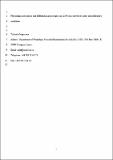Por favor, use este identificador para citar o enlazar a este item:
http://hdl.handle.net/10261/37555COMPARTIR / EXPORTAR:
 SHARE SHARE
 CORE
BASE CORE
BASE
|
|
| Visualizar otros formatos: MARC | Dublin Core | RDF | ORE | MODS | METS | DIDL | DATACITE | |

| Título: | Physiological responses and differential gene expression in Prunus rootstocks under iron deficiency conditions |
Autor: | Gonzalo Pascual, María José CSIC ORCID; Moreno Sánchez, María Ángeles CSIC ORCID ; Gogorcena Aoiz, Yolanda CSIC ORCID | Palabras clave: | Ferric chelate reductase Iron chlorosis roton extrusion qRT-PCR |
Fecha de publicación: | jun-2011 | Editor: | Elsevier | Citación: | Gonzalo MJ, Moreno MA. Physiological responses and differential gene expression in Prunus rootstocks under iron deficiency conditions. Journal of plant physiology 168 (9): 887-893 (2011) | Resumen: | Two Prunus rootstocks, the Myrobalan plum P 2175 and the interspecific peach–almond hybrid, Felinem, were studied to characterize their biochemical and molecular responses induced under iron-Deficient conditions. Plants of both genotypes were submitted to different treatments using a hydroponic system that permitted removal of Fe from the nutrient solution. Control plants were grown in 90 μM Fe (III)-EDTA, Deficient plants were grown in an iron free solution, and plants submitted to an Inductor treatment were resupplied with 180 μM Fe (III)-EDTA over 1 and 2 days after a period of 4 or 15 days of growth on an iron-free solution. Felinem increased the activity of the iron chelate reductase (FC-R) in the Inductor treatment after 4 days of iron deprivation. In contrast, P 2175 did not show any response after at least 15 days without iron. The induction of the FC-R activity in this genotype was coincident in time with the medium acidification. These results suggest two different mechanisms of iron chlorosis tolerance in both Strategy I genotypes. Felinem would use the iron reduction as the main mechanism to capture the iron from the soil, and in P 2175, the mechanism of response would be slower and start with the acidification of the medium synchronized with the gradual loss of chlorophyll in leaves. To better understand the control of these responses at the molecular level, the differential expression of PFRO2, PIRT1 and PAHA2 genes involved in the reductase activity, the iron transport in roots, and the proton release, respectively, were analyzed. The expression of these genes, estimated by quantitative real-time PCR, was different between genotypes and among treatments. The results were in agreement with the physiological responses observed. | Descripción: | 27 Pag., 5 Fig. The definitive version is available at: http://www.sciencedirect.com/science/journal/01761617 | Versión del editor: | http://dx.doi.org/10.1016/j.jplph.2010.11.017 | URI: | http://hdl.handle.net/10261/37555 | DOI: | 10.1016/j.jplph.2010.11.017 | ISSN: | 0176-1617 |
| Aparece en las colecciones: | (EEAD) Artículos |
Ficheros en este ítem:
| Fichero | Descripción | Tamaño | Formato | |
|---|---|---|---|---|
| GogorcenaY_JPlantPhys_2011.pdf | 312,2 kB | Adobe PDF |  Visualizar/Abrir |
CORE Recommender
SCOPUSTM
Citations
35
checked on 10-abr-2024
WEB OF SCIENCETM
Citations
29
checked on 27-feb-2024
Page view(s)
458
checked on 18-abr-2024
Download(s)
395
checked on 18-abr-2024
Google ScholarTM
Check
Altmetric
Altmetric
NOTA: Los ítems de Digital.CSIC están protegidos por copyright, con todos los derechos reservados, a menos que se indique lo contrario.
